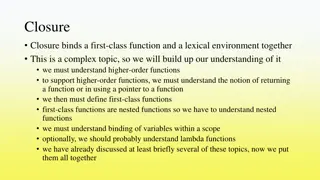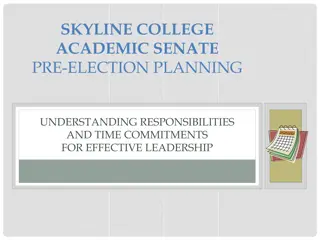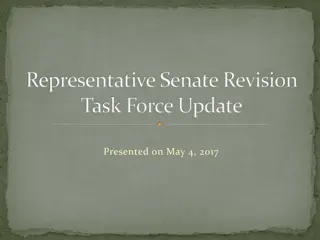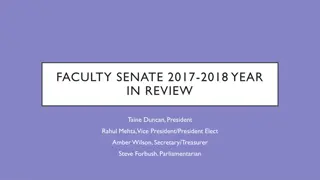Understanding the Senate: Roles and Functions
Senators are expected to be knowledgeable about a variety of issues due to representing entire states, while the Senate's rules are more flexible to encourage freedom of expression. The roles of key figures like the President of the Senate and Majority Leader in steering legislation are essential. Bills in the Senate are scheduled by leaders through specific calendars to guide the legislative process effectively.
Download Presentation

Please find below an Image/Link to download the presentation.
The content on the website is provided AS IS for your information and personal use only. It may not be sold, licensed, or shared on other websites without obtaining consent from the author. Download presentation by click this link. If you encounter any issues during the download, it is possible that the publisher has removed the file from their server.
E N D
Presentation Transcript
The Senate The Senate
1-Why are senators expected to be more knowledgeable about more issues than members of the House? Because they represent the entire state.
2-Why are rules in the Senate more flexible than in the House of Representatives? To give all senators the maximum freedom to express their ideas: unlimited debate on bills; can debate a proposal for weeks or months [only 100 senators] Senate party leaders do not usually have as much influence over members like the House leaders do.
3-Explain the roles of the following: President of the Senate- Presides over the senate, but can only vote to break a tie; May recognize members and put questions to vote, but he is not an elected representative so he cannot take part in debates or vote except as a tie-breaker. May influence members through personal contact
President pro tempore- [for the time being] Presides in absence of the President; Elected from the majority party; Usually that party s longest serving member.
Majority leader- Elected by the party, they are officials of the party, not the Senate Steers party bills through Senate by planning the work schedule and agenda in consultation with the minority leader. Makes sure that party members attend important sessions and gets support for key bills
Minority leader- Critiques the majority party s bills and to keep his party united.
Whips- Does the detailed work that supports leaders. Make sure legislators are present in the chamber when key votes come up.
4-How are bills scheduled in the Senate? Leaders control the flow of bills to committees and to the floor. Only 2 calendars: 1-Calendar of General Orders which lists the bills the Senate will consider and the Executive Calendar, which schedules treaties and nominations. The Senate brings bills to the floor by unanimous consent, a motion by all members present to set aside formal rules and consider a bill from the calendar.
5-Explain: Filibuster- To extend debate to prevent a bill from coming to a vote. A senator or a group of senators could use a filibuster to extend debate for weeks or even months.
Rand Paul, 2013 Filibuster length: 13 hours Sen. Rand Paul, R-Ky., revived the tradition of talking filibusters, protesting U.S. drone policy by blocking a vote on CIA Director John Brennan and holding the floor for just under 13 hours. Brennan eventually won confirmation. Huey P. Long, 1935 Filibuster length: 15 hours, 30 minutes Sen. Huey P. Long spent 15 hours and 30 minutes arguing against passage of a New Deal bill that would have given jobs to political enemies in Louisiana. The flamboyant Long peppered his filibuster with readings of the Constitution, Shakespeare plays and oyster recipes. Wayne Morse, 1953 Filibuster length: 22 hours, 26 minutes Sen. Wayne Morse, an independent from Oregon, set a longevity record in filibustering over tidelands oil legislation. Strom Thurmond, 1957 Filibuster length: 24 hours, 18 minutes Sen. Strom Thurmond, R-S.C., broke Morse's record with an unsuccessful filibuster against the Civil Rights Act of 1957. Thurmond, subsisting on throat lozenges, malted milk tablets and a steak sandwich, spoke 24 hours 18 minutes before concluding with the line, "I expect to vote against the bill."
Cloture Can stop a filibuster, once the filibuster is on. Cloture limits the debate by allowing each senator only one hour for speaking on a bill, but 60 senators must vote for cloture. Almost impossible to do when Dems and Reps are evenly divided to get 60 votes. Sometimes the threat of a filibuster is enough to stop action on a bill.
6-Explain three circumstances that result in a bills failing to become a law. 1-It can fail to be voted out of committee 2-It can be stopped by the rules committee 3-A Senate filibuster can force the majority of the Senate to abandon the bill
House- Speaker presides and controls who speaks Formal atmosphere 5 calendars Many ways to delay/block bills: Rules Committee, 25 years, 7 years a citizen Both Members introduce bills Majority leaders control flow of bills to committees and to the floor for debate and vote Minority leaders develop strategies to oppose or amend major party bills Senate Vice President or President pro tempore preside Both cannot vote unless to break a tie Informal atmosphere Only 2 calendars Fewer ways to block bill: filibuster 30 years, 9 years a citizen



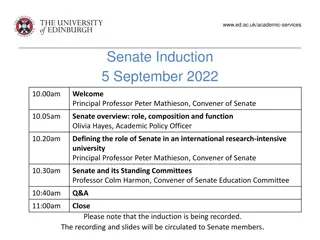
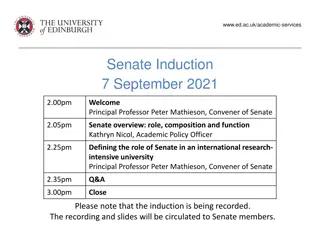
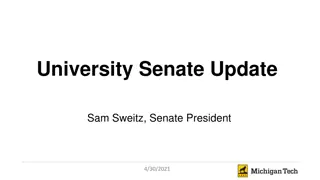


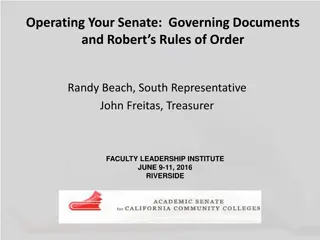





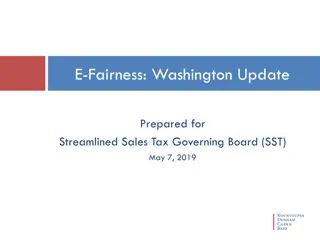

![Overview of the Faculty Senate at [Institution Name]](/thumb/233771/overview-of-the-faculty-senate-at-institution-name.jpg)




